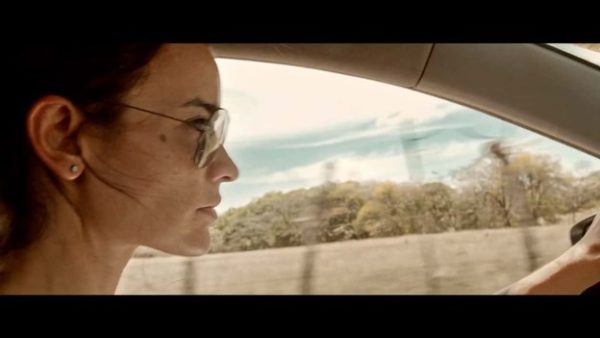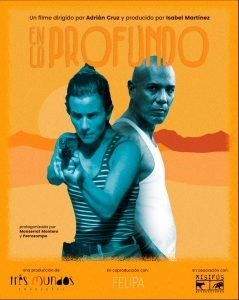Film Inspired by a Nica/Costa Rican Report on a Femicide

Local talent will work in “En lo profundo” (In the Depths), along with actress Montserrat Montero and singer-songwriter Perrozompopo.
By Cesar Arroyo (Niú-Confidencial)
HAVANA TIMES – Two policemen search for clues to solve a femicide in a dusty and isolated town. But it will not be easy: the crime occurred in a cross-border community, in that gray area where one country ends, and another begins. They must solve the case in a territory that does not trust authorities due to the historical abandonment by both governments. Although it sounds like a Wild West movie, the entire story takes place in Guanacaste, Costa Rica.
In the depths is a feature film and a fictional criminal thriller inspired by the report Femicide unpunished by Darys Mora. The publication is part of La frontera dibujada (The Drawn Border), a bi-national investigation carried out jointly by La Voz de Guanacaste, Interferencia de Radioemisoras UCR and Confidencial. The series of reports received the Jorge Vargas Gené Award in 2020, awarded by the College of Journalists of Costa Rica.
According to the film’s director, Adrian Cruz, a US screenwriter, producer and director, the narration of the story of Darys Mora’s lends itself to cinematographic interpretation.
“The way they worded the report was very, very vivid. It is not the typical article or dry journalistic chronicle, but rather something that builds on many images,” explains Cruz.
In the depths is in pre-production, and already has an impressive cast. Actress Monserrat Montero, seen in films such as Miguel Gómez’s Traveling Love and The Return of Hernán Jiménez, will play detective Amaranta Villalobos. And Perrozompopo, a Nicaraguan singer-songwriter known for songs like “Quiero que sepas” and “Entre remolinos”, will play the character of Sebastián Toruño, an experienced Nicaraguan police officer.
The production is looking now for local talent willing to bring life to the rest of the characters. The Voice of Guanacaste, a news outlet in Costa Rica, spoke with Cruz about casting details and his debut as a feature film director.
The Voice: What did you see in Darys’ story that made you think about making it into a movie?
Adrián Cruz: Gender violence is clearly an issue of high social relevance. I think that now more than ever it is on the national scene, due to the political situation in which a candidate* has a conflict and the recent march on March 8 with a huge presence of women demonstrating for an end to this other ‘pandemic’.
Femicides continue in many parts of the country and there is no end in sight. This particular one is circumscribed in a geography that gives it an additional disadvantage, that is, there is a higher probability of impunity, given the fact that it took place in a region that is not only rural and remote, but also cross-border. So that seemed to me a very traumatic situation and one that needed to be told – in this case, through fiction, but respecting the spirit of the original story. And that’s where the project gained strength. It was not just to rescue forgotten territory, but to address a problem that is more relevant than ever.
LV: Why did you choose fiction as a tool for talking about this story?
AC: The police genre and crime stories currently have a great media impact. For example on Netflix, look at the number of movies in this genre, and not only the crime fiction genre, but also documentaries. It is a subject that the mass public is interested in and we, obviously, as a production team, are interested in connecting with a wide audience, not only for commercial reasons, but also to position the subject we are talking about.
Fiction allows more creative freedom than documentary. The documentary must always be anchored to the original case, and this is a case that still has many gaps at the level of investigation. It remains unresolved, which limits the possibility of giving it closure through the documentary genre, while fiction allows for much broader creative freedoms.

LV: You decided to keep the nickname of the main suspect in the femicide: “El Ñambo”, why?
AC: I found it very, very memorable. It is a unique name, as it is an easy nickname to recognize: two syllables and in a very local dialect. As I understand it, the ñambo is a fruit from that area. And they gave this guy that nickname, I don’t know if it’s his nose or something on his face that looks like that fruit. The guy is on the run, according to what I learned, they still haven’t been able to locate him. But I thought it was kind of an interesting nod to the original case. Maybe it can give sort of sense of the original case.
In terms of sound and memory, it worked very well and that notion that it is not the name of the person but that it is a character endowed with all the aura of a fugitive who is hidden, whose supposed human essence was erased, making him the archetype of a dangerous suspect. And in the film, part of the investigators’ journey is to discover the real being behind this character.
LV: Do you plan to find most of the talent for the film here in Guanacaste?
AC: Yes, that’s the idea. With the exception of the two main protagonists, we hope that all the characters that appear in the film are from Guanacaste or even of Nicaraguan origin. Because we have that mix of both citizenships and that is also for two reasons: for a matter of ethics, to be faithful to the spirit of the situation that gave rise to the idea of the film and to be faithful to the geographical area and the people who inhabit it. And on the other hand, it is a matter of plausibility. There are physical characteristics; there are ways of dressing, and ways of speaking that are very difficult to fake, that are very difficult to reproduce. For it to really look credible, you must turn to people who are authentically from there.
LV: Where will you record and in what ways do you plan to integrate the communities where you are filming?
AC: That is part of the same proposal to be faithful to the region, right? It is not that we are necessarily going to record in the same town as the original case, because we have an idea of a dry area aesthetic, more typical of the Northwest. And in that sense, part of the idea of the tour that we are going to do now in April is to also look for the location, because we need a very abandoned town, very wild, with gravel streets. Looking for something very specific on a visual level and with many vacant lots, with hills, paddocks, houses that are very isolated from each other.
The idea is to relocate ourselves by the time filming starts and live there for the duration of the production. And that also implies that the community is involved beyond just the characters or extras, but also that lodging and meals are with local people, that the film also allows the resources we obtain to be distributed a little in those communities and in the businesses they have.
LV: How do you think the film can address, for example, realities like that of Guanacaste and other rural areas of the country?
AC: Filmmakers are often from urban areas and we end up making stories about those realities. But it is equally interesting to address what we do not know. In our case specifically, we are mainly interested in conveying that notion of real abandonment that exists in communities that have scant governmental presence — police, or institutions that could address the situation of disadvantaged people. Precisely where they are most needed is where they have the least presence.
It works as a kind of metaphor like the old west, these very remote towns where they have problems of access to telecommunications, problems of access to public transport and everything that this entails in terms of how to get the most basic things done like banking, paperwork, health care.
So, the idea is that the environment where we film reflects this isolation — that it conveys to the public that feeling of communities that are literally abandoned by the authorities, by the state, as a way of approaching those other realities that rarely appear on the screen. Our project is at the development stage, seeking financial support.
En lo profundo has already received recognition and resources from the UCR University Foundation, the Development Bank and the Ibermedia Program, an international intergovernmental fund that supports film projects in Ibero-America.
——–
*Editor’s Note: The candidate mentioned, although not by name, is now the president-elect of Costa Rica





